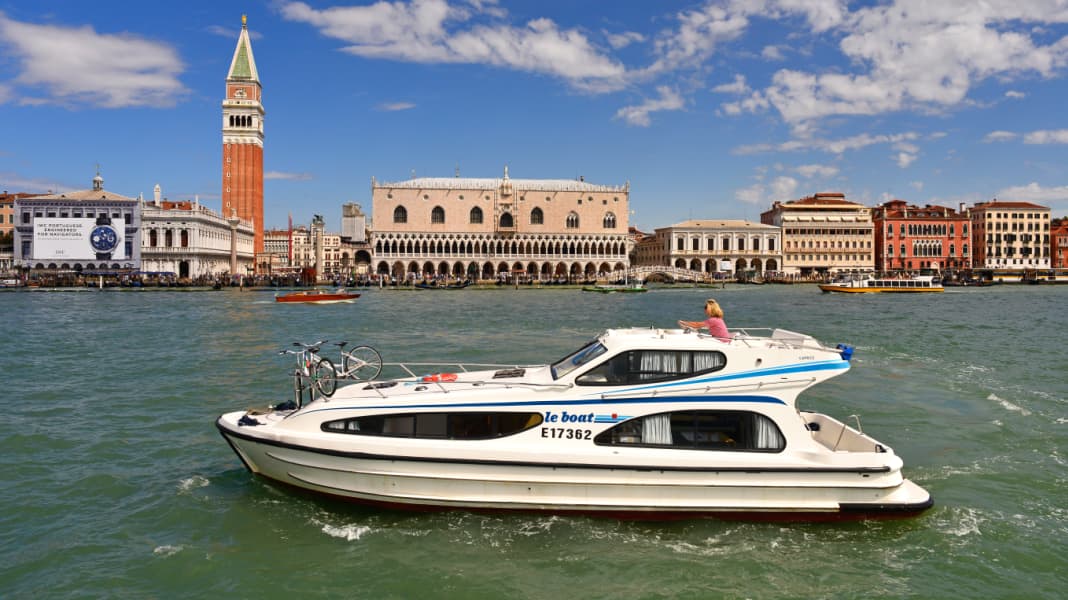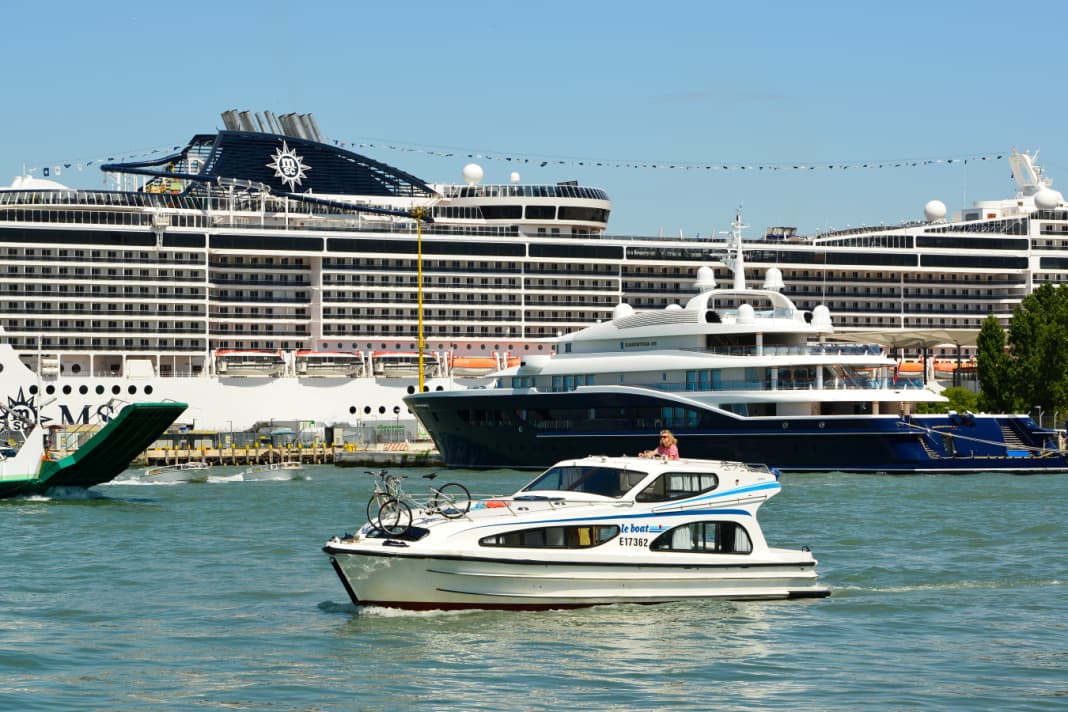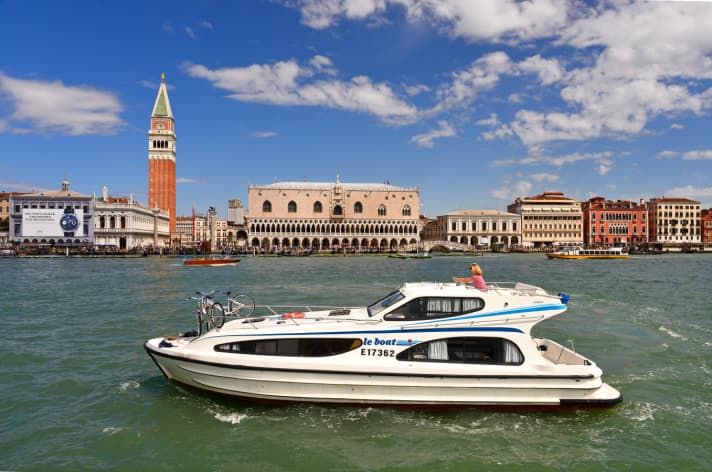







Venice - what an enchanting name! Whether you know the city or not, images of it spring to mind: The Grand Canal, the Rialto Bridge or St Mark's Square. And you automatically think of canals, gondolas and Casanova. TheLagoon city is also the most crowded tourist destination in Europe. For every 60,000 Venetians who still live in the historic centre, there are 30 million tourists every year. How can you discover Venice without drowning in the flow of these crowds?
Venice and its surrounding lagoon with famous places such as Murano, Burano or the unspoilt island of Pellestrina in the south can only be reached by boat. But which type is best suited for a voyage of discovery? The classic gondola would only be recommended within Venice and would also be too expensive in the long term. You now pay around 100 euros for an hour in a luxury floating sedan. Water taxis and vaporetti, Venice's public buses on the water, are cheaper, but somehow not particularly personalised either.
The ideal means of transport for a week-long cultural cruise therefore seems to us to be a houseboat. Not only are we independent, but we also have our accommodation with us and can explore the watersfrom Treviso in the north via Venice to Chioggia 50 kilometres further south with the exception of the city centre canals in Venice itself. But that's what the vaporetto or gondola is for...
Our trip starts at the Le Boat charter base in Casale Sul Sile, six kilometres south-east of Treviso. Strictly speaking, the town is not on the Venice lagoon, but 35 kilometres inland. Butacross the river Sile there is a navigable connection. It is the end of May and the Sile has a current that should not be underestimated. The water is greenish and you can't see the bottom. We take the outer radii of the river bends so as not to risk anything.
After an hour, we dock ten kilometres downstream in the small town of Casale Sul Sile. Coincidentally, the town has the same name as the charter base, which can lead to confusion. In Casale, we go alongside a wooden jetty and look for a supermarket. About 500 metres into town we buyProvisions for a weekin. When the young saleswoman sees what we want to lug around, she loads the supplies into her German convertible, speeds off and proudly taps the steering wheel: "Una macchina tedesca!"
We enjoy breakfast on deck. The walkers on the promenade greet us in a friendly manner. No sign of mass tourism. In the afternoon, we head further south towards Venice and at 6.30 p.m.the lock in Portegrandi. We leave the Sile and head into the Canale Silone.
Suddenly the view widens. In front of us lies the famous Venice lagoon.Avenues of wooden dolphinsherebriccole The water is called "the water's edge", stretching across the mirror-smooth surface and marking the fairway. In the shimmering afternoon heat, the silhouettes of old towns can be seen on the horizon, seemingly floating on the water. Bella Italia!
Partly flooded marshland stretches along both sides of the fairway. Set nets and stalking herons indicate an abundance of fish. The lagoon landscape was formed around 4000 years ago by river deposits. From the eighth century onwards, the towns were connected by canals. During theThe heyday of the Republic of Venice - from the 11th to the 18th century - finally the canal system in its present form was created.
We pass several fairway junctions. The further south we go, the heavier the traffic becomes. Water taxis, excursion boats, transport barges,Vaporetti and lots of small motorboats meet us with an impressive wave. Nobody takes their foot off the accelerator, even though the speed for the next section of the canal is posted at every junction. The speed limit is usually 7 km/h. However, I have the impression that we and our houseboat are the only ones who adhere to it.
Burano now lies ahead, dominated by the Campanile San Martino. The campanile isa typical Venetian bell towerfree-standing next to the nave. In Burano, however, it has leaned so much over the years that people think it is about to topple over.
Burano is a typical lagoon town with no roads or ferry connections. Apart from handcarts, there is no traffic;the boat is the most important means of transport. Footpaths stretch along the canals, connected by bridges. The two-storey houses on the banks of the canals are brightly painted.
We drive round Burano and enjoy the "views". We prefer not to go in ourselves: the canals are just as wide as our Caprice is long. Every free metre of shoreline is also occupied by boats.But the charter base has taken precautions and reserved moorings at interesting places in the area, in this case on the neighbouring island of Mazzorbo, which is connected to Burano by a wooden bridge.
As we stroll through the alleyways of Burano in the evening, it is surprisingly quiet. The last tourist boats have just left. TheLace embroiderers The people in the neighbourhood are putting their racks of doilies, curtains and lingerie back in the low houses, shops and cafés are closing. Only the "Trattoria al Gatto Nero da Ruggero", located at a canal crossing, is still open.
In the morning, we continue towards Venice. Our next stop is the island of Murano, which is larger than its little sister Burano and has twice as many inhabitants. Here you can clearly feel the proximity of Venice, which is only a kilometre away. From the landing stage in the south of the city, the vaporetti run every minute. Next to them, the water taxis stop - only for seconds at a time to pick up guests and then set off again at speed. In between, small freighters bring building materials, mineral water or fruit and vegetables. DHL and FedEx motorised ships sail parcels through the canals. In the middle of the hustle and bustlethe police and refuse collection boats. We round Murano to the south and find a place on a new floating dock in the canal in front of the Marina Murano shipyard.
Murano is theCity of glassblowers. In the south-west of the town, you can watch them at work in several factories. The town centre is located on the main canal, the Rio dei Vetrai. During the day, tourists push their way through alleyways lined with one glass gallery after another. This city centre only quietens down again in the evening. There are only a few boats left at the main jetty and the restaurant there has also emptied out. We eat spaghetti with seafood and enjoy a glass of red wine while watching the sunset.romantic view over the lagoon.
It's Saturday and Venice is within reach. But we don't want to invade the tourist stronghold at the weekend. We have therefore chosen Chioggia in the far south as our next destination.
But we still have to pass Venice. The shipping traffic is like a six-lane motorway. With our houseboat, we creep along in the hard shoulder and are still overtaken on both sides. The boat rocks so much that everything that isn't secured flies around - and there's no wind at all!
We round Venice in the south-east and havethe world cultural heritage site with its churchespalaces and canals to starboard. Many of the small boats dart into the canals, where they share the narrow fairway with the gondolas. The dilapidated state of the city is obvious: Damp patches, mould and crumbling facades are apparently normal.
We steer along the Canale di San Marcoin the direction of St Mark's Square. While the immense shipping traffic used to be comparable to a motorway, there is now sheer chaos here - at least from our point of view. Hundreds of boats, yachts and ships are travelling back and forth. The resulting swell is more than a metre high. It's a miracle that nothing happens here. In terms of size, everything that can swim sails here - from gondolas to cruise ships. And yet it still gives you goosebumps to stand in front of the Doge's Palace by boat and look down into the sea.Grand Canal to look.
Few people know the names of the Venetian Doges, who ruled the Republic of Venice from their magnificent palace here for over 700 years. But everyone knowsthe most prominent Venetianwho had been a prisoner high up under the lead roofs of the ornate façade since 26 July 1755:Giacomo Casanovathe famous seducer of women, sat in one of the seven high-security cells in the eastern part of the building, in the direction of the Bridge of Sighs. The low cells under the roof of the palace are said to have been relentlessly cold in winter and unbearably hot in summer.
However, Casanova was not imprisoned for amorous adventures, but for political reasons. He was imprisoned for blaspheming against the authorities, possessing banned books and socialising with strangers. After 15 months, on the night of 31 October 1756, he managed tohis spectacular escapeThrough a hole in the ceiling he had reached the roof and climbed back into the palace via a skylight in another part of the building. Disguised by his elegant clothing, which he also wore during his imprisonment, he then left the palace through the main portal, which the unsuspecting guards opened for him themselves.
His report "My Escape from the Lead Chambers of Venice" was published in 1788 by Verlag Schönfeld in Leipzig and has been the world's most successful book set in Venice for over 200 years.No Venetian after himhas achieved such fame. Today, there are more than 70 books and 16 feature films about Casanova's adventures, including a German silent film from 1928, four feature films from West Germany and one from East Germany.
On Saturday lunchtime, the Canale di San Marco fills up with excursion boats full of tourists. The swell in front of the Doge's Palace becomes unbearable. At the first sign of seasickness, we leave Piazza San Marco astern and head south to the Doge's Palace.Lido peninsula. This elongated dune separates the lagoon of Venice from the Adriatic Sea. The islands of Lido and the dune that continues southwardsIsland of Pellestrina They also serve as natural defences against storm surges. The valuable building fabric is nevertheless under threat: the churches, palaces and secular buildings resting on oak piles are sinking deeper and deeper from year to year. At the same time, the sea level is rising and the floods are becoming more devastating. The main entrances to most buildings are already only a few handbreadths above mean sea level.
Between the islands of Lido and Pellestrina, and at the two other crossings between the lagoon and the open sea, Italy's largest construction sites have therefore been underway since 2003. As part of the MO.S.E. (modulo sperimentale elettromeccanico) project, around six billion euros are being spent onThree gigantic flood protection gates which, when completed in 2016, will protect the city of Venice and the entire lagoon from flooding.
The mega construction project has been ecologically and politically controversial from the outset, primarily because the financial holding company of the former scandalous head of government Silvio Berlusconi is involved in the billion-euro deal anda corruption scandal chasing the next. In connection with MO.S.E., the former mayor of Venice and 34 other politicians and building contractors have already been arrested and brought to trial for money laundering, extortion in office and embezzlement.
The lagoon fairway along the needle-shaped island of Pellestrina is one of the most beautiful sections of our trip. There are five small fishing villages on the island, which have almost grown together. One place is more beautiful than the next. The small houses shinein bright colours from orange to pink and are reflected in the lagoon. The residents' boats are moored in front of them, as everything here is also brought in by water. Most of the few tourists come from the region. The best restaurant with a jetty is the fish restaurant "da Celeste".
We reach Chioggia in the afternoon,the southernmost point of our journey. The town is a lagoon city like Venice, but much smaller and without mass tourism from abroad. Here you can still watch the lagoon fishermen unload their fresh produce and sell it in the centre of town at the fish market, which is well worth seeing. In Chioggia, you can reach the wide sandy beach of the Adriatic after three kilometres on foot or by bike. Those familiar with the beaches of the Baltic Sea will be less than impressed: In Chioggia, every square metre of beach is covered with sun loungers and parasols, which are rented out by the day. Nevertheless, we areEnthusiastic about Chioggiaespecially because of the original flair in the enchanting old town.
On Sunday evening we head back towards Venice, the actual destination of our cruise, and assume that the weekend trippers have disappeared. We steer intothe Marina Sant'Elena, which is still under construction in the south-east of the old town and have almost the entire harbour to ourselves. As the harbour is still under construction, there is no service - but the World Heritage Site is right on the doorstep: it's a 25-minute walk to St. Mark's Square. If that's still too strenuous, you can hop on a vaporetto not far from the marina. The floating buses take you quickly to any part of the city.
Hundreds of books describe the sights of Venice. As first-time visitors, we find it moving to walk across the Piazza San Marco.At the sight of the Doge's Palace and the Basilica di San Marco, we catch a glimpse of the wealth and power of the former "Republic of Lions". The best view of the countless villas and palaces can be obtained by taking the vaporetto from St Mark's Square across the Grand Canal to the railway station, changing there in the opposite direction and then getting off again at the Rialto Bridge.
We cross the bridge, which is bursting with tourists, the lively Mercato Rialto and take a gondola on the banks of the Grand Canal. At the blue hour, we let the gondolier row us across the main canal into the labyrinth of tiny canals in the historic centre.The morbid charm The melancholy mood is intensified by the pale light of the dim lanterns and the palaces corroded by the damp.
It is the mood in which the melancholy verses of great poets memorialised the city. Inevitably one thinks of"When the gondolas carry sorrow" by Daphne du Maurier or Thomas Mann's novella "Death in Venice". Modern crime novels and spy films from James Bond to Commissario Brunetti also play with the melancholy and charm of Venice. Butalso in matters of love Venice's much-vaunted "tristezza" seems to have an inspiring effect: countless other novels and films are set in the lagoon city.
Our gondolier dodges oncoming traffic on the dark, narrow canal, takes a sharp left turn and passes under a low stone arch bridge. On the port sideA gloomy palace with a crumbling façade. "This is the house of the most famous Venetian. Giacomo Casanova lived here before they put him in the lead chambers." The building looks desolate, there is no light anywhere. "After his exile, he came back once more. The Venetians say that his spirit still hovers over the small canals where the gondolas with the lovers travel."
The next day it's time to say goodbye. We leave Venice behind and head north towards Treviso. As our last stop in the lagoon, we choosethe monastery island of San Francesco del Deserto. There is no public transport here, but private boats are allowed to dock at the monastery. After his return from Palestine in 1220, the preacher Francis of Assisi chose this island as a place of peace and tranquillity. A small Franciscan monastery has existed here ever since. The two cloisters and the monastery garden can still be visited today.Places of perfect silence.
As is so often the case, a charter week is over far too quickly. And there is a sense of melancholy as we leave Venice, Murano, Burano and San Francesco del Deserto with their campaniles towering into the blue sky in our wake.We found it excitingWe recommend this trip to anyone who loves art, culture and the Italian way of life
FURTHER INFORMATION
The charter company
The charter company Le Boat, which belongs to the TUI Group, is the leading houseboat hire company in Europe, with territories in Germany, France, Italy, England, Ireland, Poland, Scotland, Belgium and Holland. The fleet includes around 900 houseboats up to 14.97 metres in length. In Italy, Le Boat operates charter bases in Casale Sul Sile and Precenicco for trips on the Venice Lagoon and the Marano Lagoon respectively.
The boat
Our Caprice houseboat has two double cabins with en-suite bathrooms (shower/WC). Two additional berths are possible in the saloon. There is an inside and an outside steering position. Despite its size, the boat is relatively easy to drive, but mooring is practised at the charter base. Charter boats may be driven on the lagoons of the Italian Adriatic coast without a licence. Trips to the open sea are not permitted.
Technical data: Length: 12 m, draught: 1 m, engine: 40 hp, weekly prices: from 1305 euros (low season) or from 2,500 euros (high season). Operating costs per engine hour: 11.50 euros. Flat rate for the houseboat moorings in the Venice lagoon: 80 euros/week.
The journey
There are flights to Venice from all major German airports. With a budget airline, tickets (there and back) cost around 200 euros. The journey from Marco Polo Airport near Venice to the Casale charter base (23 km) takes half an hour and costs 80 euros with a transfer from Le Boat and 60 euros with a taxi.
Information and booking
Le Boat, Theodor-Heuss-Str. 53-63, 61118 Bad Vilbel Tel.: 06101-557 91 12, www.leboat.de www.leboat.de
Cruising guide and charts

